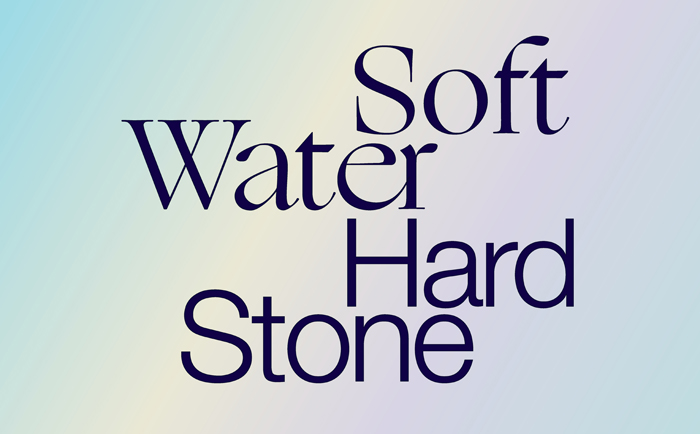Press Release
New York, NY...The 2021 : New Museum Triennial, Soft Water Hard Stone, brings together works across mediums by forty artists and collectives living and working in twenty-
The title of the 2021 Triennial, “Soft Water Hard Stone,” is taken from a Brazilian proverb, versions of which are found across cultures: Água mole em pedra dura, tanto bate atéque fura Soft water on hard stone hits until it bores a hole The proverb can be said to have two meanings: if one persists long enough, the desired effect can eventually be achieved; and time can destroy even the most perceptibly solid materials.

2021 New Museum Triennal, Soft Water Hard Stone
New Museum of Contemporary Art, New York (United States)
28.10.2021 - 23.01.2022

The title speaks to ideas of resilience and perseverance, and the impact that an insistent yet discrete gesture can have over time. It also provides a metaphor for resistance, since water— constantly flowing and transient material—s capable of eventually dissolving stone— substance associated with permanence, but also composed of tiny particles that can collapse under pressure.
In this moment of profound change, where structures once thought to be stable are disintegrating or on the edge of collapse, the 2021 Triennial recognizes artists re-
Throughout the exhibition, artists address the regenerative capabilities of the natural world and our inseparable relationship to it, and grapple with entrenched legacies of colonialism, displacement, and violence. Their works look back at overlooked histories and artistic traditions, while at the same time look forward to the creative potential that might give dysfunctional or discarded remains new life. It is through their reconfigurations and reimaginings that we are reminded not only of our temporality but of our adaptability—undamental characteristics we share, and which keep us human.
The proverb that gives the exhibition its title was the inspiration for a work by Gabriela Mureb, Machine #4 – stone (ground) (2017). The work consists of a small motor that activates an aluminum rod that repeatedly hits a stone in a steady staccato. Over time, the rod will eventually bore a hole in the stone, creating a fine powder that accumulates and dissolves into the surrounding atmosphere. Depending on the duration of the work’ display, this hole will alter the stone’ weight, potentially causing it to topple over. One of the smallest works included in the exhibition, the piece provides a potent metaphor for ideas surrounding determination, reciprocity, and revolution, as the antique motor steadily hums.
A number of artists in the exhibition including Ann Greene Kelly, Blair Saxon-
Other artists, such as Angelika Loderer, Jes Fan, and Iris Touliatou, present works that shift, dissolve, decay, transmute, and fade away. Tómas Díaz Cedeño’1000 años (2019) is a stalactitelike arrangement of poured concrete sculptures connected to an irrigation system, which sends drops of water down the chains and concrete to pool into ceramic bases. Like the exhibition’ titular proverb, the water slowly dissolves particles in the concrete and seeps into its structure, keeping it in a state of gradual yet persistent transformation.
Within “oft Water Hard Stone,”many works directly interplay with the gallery architecture, affecting the viewer’ physical experience of the space and objects in relation to their bodies. Laurie Kang’ Great Shuttle (2020–21) replaces the typical temporary drywall traditionally used in museums, dividing the exhibition space with flexible track and steel studs affixed with continually sensitive, unprocessed photographic film that will shift over time. This relationship between architecture and the body is taken up in many other works that portray the built environment as an extension of our own corporeality, including Yu Ji’ Flesh in Stone series (2012–ongoing), Krista Clark’ Annotations on Shelter (2021), and a new work by Kate Cooper.
Clay Theory (2019), a stereoscopic 3D film by Amalie Smith delves into the profound connections that exist between humans and the Earth, as well as the concept of artificial life. In the work, Smith speaks to scientists about the DNA compositions of the human body and clay, and to art historians about ancient Cypriot terracotta figures that were once thought to be alive. Hera Büyüktaşcıyan’ Nothing Further Beyond (2021), Gaëlle Choisne’ Temple of love – Love to love (2021), and a new large-
For some artists in the exhibition, a complex materiality emerges, one invested in local contexts and personal histories. A suite of tabletop sculptures by Kahlil Robert Irving appears as ordinary materials and refuse, but are produced entirely in ceramic, and are imprinted with the residues of time and the post-
Other artists, including Kang Seung Lee and Rose Salane, create new forms of archives as an act of recuperation, reconciling under-
Finally, the politics of visibility and social space are represented in videos, installations, and sculptures that examine cultural inheritance and the role of history and the state in systems of oppression. Jeneen Frei Njootli’ Fighting for the title not to be pending (2020) is composed of the artist’ weight in beads, which can be found in various cracks and corners throughout the Museum. Fighting articulates a dichotomy of absence and presence, alluding to the ongoing disenfranchisement and violence against Indigenous people throughout the world. These works are joined by Sandra Mujinga’ speculative exploration of Blackness and visibility in the three-
“Soft Water Hard Stone”follows the previous installments of the New Museum Triennial, “ounger Than Jesus”(2009), “he Ungovernables”(2012), “urround Audience”(2015), and “ongs for Sabotage”(2018).
ARTIST LIST : Haig Aivazian, Evgeny Antufiev, Alex Ayed, Nadia Belerique, Hera Büütaşıan, Gabriel Chaile, Gaële Choisne, Krista Clark, Kate Cooper, Cynthia Daignault, Tomá Díz Cedeñ, Jes Fan, Jeneen Frei Njootli, Goutam Ghosh, Harry Gould Harvey IV, Clara Ianni, Kahlil Robert Irving, Arturo Kameya, Laurie Kang, Bronwyn Katz, Ann Greene Kelly, Kang Seung Lee, Amy Lien and Enzo Camacho, Angelika Loderer,Tanya Lukin Linklater (Alutiiq), Sandra Mujinga, Brandon Ndife, Erin Jane Nelson, Ima-

Image: Exhibition Title Design by Studio Pacific
Exhibition 28 November 2021-

© ArtCatalyse International / Marika Prévosto 2021. All Rights Reserved